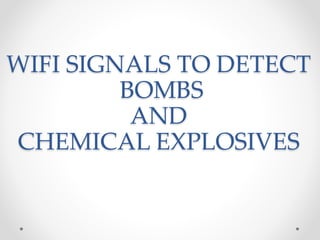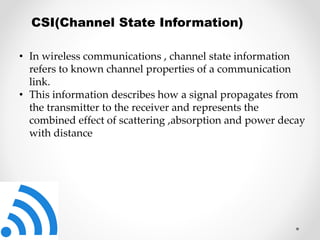WIFI SIGNALS TO DETECT BOMBS AND CHEMICAL EXPLOSIVES
- 1. WIFI SIGNALS TO DETECT BOMBS AND CHEMICAL EXPLOSIVES
- 2. Contents ŌĆó Introduction ŌĆó Requirement ŌĆó Working ŌĆó System overview ŌĆó Two Wi-Fi antenna Setups ŌĆó Object Risk Estimation ŌĆó Conclusion ŌĆó References
- 3. INTRODUCTION ’é¦ The growing needs of public safety urgently require scalable and low-cost techniques on detecting dangerous objects hidden in baggage. ’é¦ Traditional baggage check involves either high manpower for manual examinations or expensive and specialized instruments .
- 4. ’é¦ A system have developed that uses ordinary Wi-Fi to easily detect weapons , bombs and explosive chemicals in bags with nearly 90 per cent accuracy , demonstrating low-cost technology for security screening.
- 5. REQUIREMENT ’é¦ A Wi-Fi device ’é¦ 2 to 3 antennas ’āś A Wi-Fi device with 2 to 3 antennas and can be integrated into existing Wi- Fi networks with low-cost and deployment efforts , making it more scalable and practical than the approaches using dedicated instruments.
- 6. WORKING ŌĆó This approach uniquely separates the wireless interface caused by two influencing factors of objects i.e., material and shape ŌĆó To identify different materials we exploit the Wi-Fi signal transmitting through or bypassing the objects , which result in different characteristics like absorption , refraction and reflection in CSI values from antennas and their difference. ŌĆó We can estimate its shape (width and height)or volume based on the finding that the strength of the reflected signal is proportional to the reflection area of the object.
- 7. CSI(Channel State Information) ŌĆó In wireless communications , channel state information refers to known channel properties of a communication link. ŌĆó This information describes how a signal propagates from the transmitter to the receiver and represents the combined effect of scattering ,absorption and power decay with distance
- 11. Object Risk Estimation through Reflection- Based Object Imaging 1. Extracting Reflected Signal from CSI Complex
- 12. 2.Volume Estimation for Liquid Objects in Baggage
- 14. CONCLUSION ŌĆó To detect the suspicious objects using Wi-Fi technology . ŌĆó No installation of high-cost security checking's infrastructures . ŌĆó It can estimate the risk level of the object. ŌĆó Extensive experiments are conducted with 15 objects and 6 bags over a 6 month period. The result show that this system can detect over 95% dangerous objects in different types of bags and successfully identify 90% dangerous material types.
- 15. REFERENCES ŌĆó P. MAZZEI, ŌĆ£Florida school, on edge since shooting, requires students to carry clear backpacks,ŌĆØ https://www.nytimes.com/ 2018/03/21/us/’¼éorida- school-shooting-clear-backpacks.html, 2018. ŌĆó https://ieeexplore.ieee.org/document/8433142
















